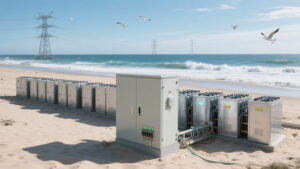Table of Contents
ToggleI. Core Definition: The Hub of Modern Power Distribution
A Power Box (distribution board) is a critical device in electrical systems that realizes power distribution, control, and protection. It distributes power from the source to various circuits through components like circuit breakers and switches. As the “terminal command center” of power networks, it ensures electrical safety and is an important component of smart grids.
According to IEC 61439 standards, a Power Box is defined as “a complete set of equipment consisting of busbars, circuit breakers, measuring instruments, etc., that performs power reception and distribution functions.”
 II. Structural Composition: A Multi-Layer Protection System
II. Structural Composition: A Multi-Layer Protection System
Modern intelligent Power Boxes contain these core components:
Enclosure System:
Materials: Cold-rolled steel/stainless steel/engineering plastic
Protection level: IP65 (outdoor)/IP42 (indoor)
Corrosion resistance: C4 (industrial)/C5 (marine)
Electrical Components:
Incoming unit: Main circuit breaker, disconnect switch
Distribution unit: Branch circuit breakers, leakage protectors
Control unit: Contactors, relays
Monitoring unit: Smart meters, power monitoring devices
Intelligent Systems:
Communication: RS485/Ethernet/4G
Sensors: Temperature sensors, current transformers
HMI: Touchscreen, status indicators
Table: Comparison of Power Box Types
| Type | Rated Current | Protection Level | Smart Features | Main Applications |
|---|---|---|---|---|
| Indoor DB | ≤250A | IP42 | Basic protection | Homes, offices |
| Industrial DB | ≤1600A | IP65 | Overload protection | Factories, workshops |
| Outdoor DB | ≤630A | IP66 | Lightning protection | Municipal facilities |
| Smart DB | ≤2500A | IP54 | Remote monitoring | Data centers |
III. Core Functions: Multiple Missions of Power Management
Power Distribution:
Divides main circuit into multiple branches
Achieves three-phase load balancing
Provides different specification power interfaces
Circuit Protection:
Short-circuit protection: Instant fault circuit interruption
Overload protection: Prevents line overheating
Earth leakage protection: Ensures personal safety
Intelligent Management:
Real-time power quality monitoring
Remote on/off control
- Fault early warning and location
IV. Technical Highlights: Innovative Breakthroughs in Smart Distribution
Modular Design:
Standard modular dimensions (1P=18mm)
Quick-installation rail system
Expandable structure design
Safety Protection:
Arc fault detection (AFCI)
Double insulation isolation
Emergency mechanical interlock
Smart Connectivity:
IoT remote monitoring support
Power quality analysis
Cloud data management
Energy Saving:
Tin-plated copper bars reduce energy consumption
Eco-friendly materials
Energy efficiency optimization algorithms
 V. Applications: Full Coverage From Homes to Industries
V. Applications: Full Coverage From Homes to Industries
Civilian Sector:
Residential distribution: Standard indoor DB for each household
Commercial buildings: Zoned distribution system
Public facilities: Lighting, elevator dedicated DBs
Industrial Sector:
Production line distribution: Power distribution boxes
Equipment control: Motor Control Centers (MCC)
Special environments: Explosion-proof boxes (Ex d)
Infrastructure:
Municipal power: Outdoor ring main units
Transportation: Metro, airport dedicated distribution
Renewable energy: PV combiner boxes
VI. Selection Guide: Choosing the Right Power Box
Capacity Calculation:
Total capacity ≥ Total equipment power × diversity factor
Branch circuit capacity ≥ Connected equipment power × 1.25
Environmental Considerations:
Outdoor: IP65 protection, UV-resistant materials
Corrosive environments: Stainless steel 316
High temperature: High-temperature resistant components
Smart Requirements:
Basic: Local manual operation
Standard: Local monitoring + data recording
Advanced: Cloud access + remote control
VII. Installation Standards: Safety-First Engineering
Location Requirements:
Dry, ventilated, easily accessible
Height from floor: 1.5-1.8m
Away from flammable/explosive areas
Wiring Requirements:
Torque-compliant copper bar connections
Wire gauge matching circuit breakers
Clear phase identification
Safety Clearances:
Box-to-wall distance ≥10cm
Phase-to-phase distance ≥20mm
Maintenance access width ≥80cm

 II. Structural Composition: A Multi-Layer Protection System
II. Structural Composition: A Multi-Layer Protection System V. Applications: Full Coverage From Homes to Industries
V. Applications: Full Coverage From Homes to Industries


